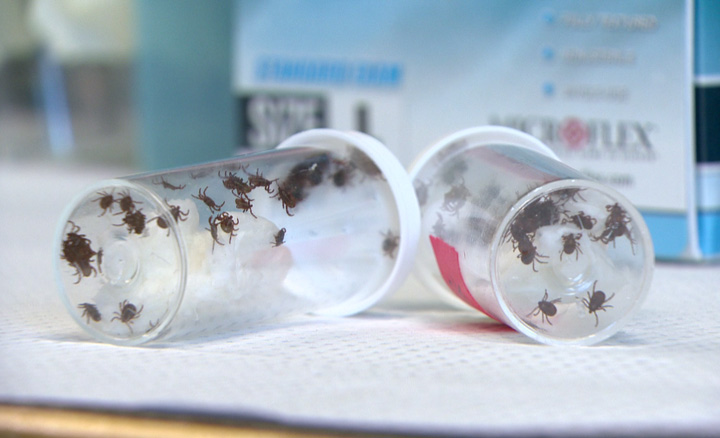With spring well underway and people starting to venture outdoors more, Interior Health is warning to keep an eye out for ticks.

Approximately the size of a sesame seed, ticks are small bugs that feed on the blood of humans and animals.
WATCH BELOW (Aired June 12, 2018): Mother warns parents about the dangers of tick bites after daughter suffers paralysis

According to Interior Health (IH), ticks are prevalent throughout the Interior Health region and are typically found in tall grass and wooded areas.
“They are easiest to spot on a person or pet when they are actually sucking blood,” said IH. “Ticks burrow part way into the skin, bite, draw blood and then drop off.”
IH added that while feeding, the tick’s mouth will be under the skin, but the back parts will be sticking out. When they’re full of blood, or engorged, they are usually blue-grey in colour.
IH said ticks can sometimes transmit diseases, and that general symptoms of tick infections include fever, headache, muscle pain and a rash.
WATCH BELOW (Aired July 6, 2018): How to protect your pet against ticks

The species of ticks most commonly found through the Interior Health region are wood ticks. Wood ticks do not carry the Lyme disease bacteria, but they can carry other diseases such as Rocky Mountain spotted fever.
“Ixodes ticks are the species that transmit Lyme disease,” said IH. “They are more common throughout Coastal B.C., but may be present in some Interior Health areas.”
IH said less than one per cent of Ixodes ticks in B.C. carry Lyme disease but noted it’s still important to recognize a possible infection. In addition to fever, headache and muscle pain, IH said people infected with Lyme disease will often develop a rash that looks like a bull’s-eye target that expands from the site of the tick bite.
WATCH BELOW (Aired Jan. 11, 2019): Python covered with more than 500 ticks rescued in Australia

Below are tips from Interior Health regarding ticks.
What to do if you find a tick:
- It is important to remove ticks found on people and pets. To do so, wear gloves and use needle nose tweezers to gently grasp the tick close to the skin. Pull the tick straight out without squeezing it.
- After the tick is removed, clean the area with soap and water. If the tick is alive (live ticks can be tested for Lyme disease), you can save it in a sealed container with a cotton ball soaked in water.
- Record the date of the bite on the container. If you have concerns or need assistance removing a tick, please contact your doctor or visit a walk-in medical clinic.
- Although most tick bites are harmless, it is important to watch for signs of illness and see a doctor as soon as possible if you notice a bull’s-eye rash or other symptoms. If you saved the tick, bring it with you to your medical appointment.
Precautions to prevent tick bites and tick-related illnesses:
- Walk on cleared trails when in tall grass or wooded areas.
- Cover up by wearing a hat, long sleeves and pants.
- Wear light-coloured clothing to help spot ticks easily.
- Tuck pant legs into socks or boots.
- Apply insect repellent containing DEET on uncovered skin.
- Check clothing and scalp (covered or not) when leaving an area where ticks may live. Ask someone to help check hard-to-reach areas.
- Have a shower after returning from areas where ticks may live.
- Regularly check household pets for ticks.
To help keep ticks away from your home and yard, you can:
- Keep your lawn short and remove any fallen leaves and weeds.
- Keep a buffer area such as a wood-chip or gravel border between your lawn and wooded areas or stone walls. Any play equipment or play zones should be kept away from wooded areas.
- Trim tree branches to allow more sunlight in your yard.
- Keep wood piles and bird feeders away from the house.
- Widen and maintain trails on your property.


Comments